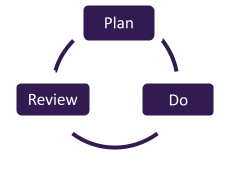6.9: Planning
- Page ID
- 86774
As with most endeavors, we are more effective when we plan curriculum ahead of time. This helps us to be prepared and to adjust our ideas to be flexible as the children engage with what we have planned.
Reasons to plan:
- Make sure our plans meet the needs, interests, and abilities of the children
- Make sure we understand the learning and development that will occur
- Make sure we have all the materials we will need
- Make sure we know where in the environment to set up
- Make sure we know how to set up
- Make sure we know how to encourage children to participate
- Make sure we have thought through behavioral issues that might arise and how to handle them
- Make sure we have thought through the interactions that will take place
- Make sure we know how we will encourage the children to clean up
- Make sure we know how we might gather observational notes
- Make sure we have thought through how we might document and share this experience with parents or others.
|
|
Pause to Reflect Do these make sense to you? Are there others? |
If we have planned thoroughly and thoughtfully, it allows us to implement our plans and to reflect on them afterward, using that information for future planning.
Often referred to as the Plan - Do (implement) - Review (evaluate) cycle, this type of approach allows us to continuously provide the most effective curriculum to the young children in our care.

Figure \(\PageIndex{1}\): Plan Do Review Cycle
Chapter 7 (Learning Environments), will discuss early childhood daily routines in more detail. For now, let us consider that most programs are broken down into segments of the day, beginning with the arrival of the children and ending with their departure. Teachers will plan for all segments of the day, both inside and outside, which might include:
- Arrival and Departure
- Small group time
- Large group time
- Centers
- Child initiated play
- Nutrition (snack, lunch,…)
- Self-help (washing hands, toileting, napping,…)
- Transitions between all segments of the day
- Others as each program dictates
One of the best planning strategies is to use a written format. Sometimes we plan one activity or experience on a single form. Other times we plan for multiple experiences on the same form. New teachers are often encouraged to plan each activity separately at first until they feel comfortable with the process.
Reasons for a written plan:
- Keeps things in order
- Assures everything is thought through and not forgotten
- Can be referred to as needed throughout the process
- Can be shared with others
- Documents planning for record-keeping purposes
- Can be saved to be repeated or modified without having to start from scratch
|
|
Pause to Reflect Do these make sense to you? Are there others? |
When planning it can be helpful to know that certain terms are used in a variety of ways by various programs. Because this chapter is written for a diverse group of future early childhood educators, we will use these terms interchangeably so that you are ready for the vocabulary used wherever you may work.
Some of the terms most frequently used to represent the “goings-on” you will plan for are:
- Lesson
- Activity
- Learning Experience
- Curriculum
- Teaching Moment
While they may have slightly different “official” meanings, they overlap in our field and can all be found to begin with a plan based on children’s interests and needs, implemented according to the plan (with modifications as they occur), and reviewed/evaluated afterward through reflection to assess and build upon for the future.
Below are examples of generic planning forms (used later in other ECE courses at College of the Canyons). You will see planning for a specific activity and planning for the entire day. For each there will is a blank version and a sample version. The programs you work in will each have their own unique method and planning forms, but most will include some, if not all, of the information included here.
Blank Example Planning Form for Specific Activity
|
CURRICULUM / ACTIVITY IMPLEMENTATION PLAN Title / Description:
Resources (Where did you learn about this activity) :
Reason(s) for Curriculum Plan (justify by considering developmental milestones, learning domains, observations in your assigned children’s classroom, and your knowledge of child development, milestones, word picture handout & DAP that guided your decision to implement this particular activity)
Ages of Children: Number of Children:
Location:
Segment of Daily Routine:
Materials Needed (be specific-quantities, color, book and song titles, etc.)
Implementation / Directions (List step-by-step as if the implementation could be replicated without you; include set up and clean up, involving children whenever possible. Step-by-step description of learning activities with specific detail.) Describe step-by-step what the children will be doing.
Now describe your role. Your guidance supports a maximum learning environment. Flexibility and supporting the child’s process is vital. Questions to ask yourself: How will you introduce the activity? How will you engage the children? What will you be doing/saying? What is your role during the activity ? What open-ended questions will you be using? Please include a minimum of 3 open-ended questions for your activity.
Specific ways this activity will facilitate development: Physical: a) b) Cognitive: a) b) Language: a) b) Social/Emotional: a) b) Creative: a) b) Behavioral Considerations (Plan ahead…what issues might arise/what strategies might help) : a) b) c)
Documentation How will you collect and display the development listed above? (documentation board, classroom book, PowerPoint, Prezi, creative ideas, etc.):
Webbing Ideas ( List at least 5 activities to extend the learning into other areas; try to include one appropriate use of technology):
Modifications to include ALL children (developmental delays, disabilities, cultural and linguistic diversities, etc.): a) b) c)
Inclusion of Parents/Families:
Other Notes/Considerations: |
Sample Planning Form for Specific Activity
|
CURRICULUM / ACTIVITY IMPLEMENTATION PLAN Developed by: Suzie Student Title/Description: Nature Scavenger Hung Resources (Where did you learn about this activity) Mr.Bossman, my mentor teacher implemented this activity with his class. Book Resource: Nature Fun Curriculum Guide , by I.B. Squirrly, Acorn Press, 2019 Reason(s) for Curriculum Plan (justify by considering developmental milestones, learning domains, observations in your assigned children’s classroom, and your knowledge of child development, milestones, word picture handout & DAP that guided your decision to implement this particular activity) As the season is changing, several children have commented on observations they are making in nature (leaves are falling, colors are changing, weather,…). They have been showing a lot of interest in books related to nature. They are also bringing in items they are finding on the ground in their homes or community (pinecones, sticks, leaves…) Ages of Children: 4 Number of Children: 20 (entire class) Location: outside on the yard Segment of Daily Routine: outside time Materials Needed (be specific-quantities, color, book and song titles, etc.) (NAEYC Standard 1c):
Implementation / Directions (List step-by-step as if the implementation could be replicated without you; include set up and clean up, involving children whenever possible. Step-by-step description of learning activities with specific detail.) Describe step-by-step what the children will be doing. Begin by welcoming the group and letting them know how happy we are they have joined us. Invite children to assist in finding some objects. Divide children into small groups and give each group 1 scavenger hunt list. Encourage the children to find the objects on the list. Remind children of the behavioral expectations for the activity. Now describe your role. Your guidance supports a maximum learning environment. Flexibility and supporting the child’s process is vital. Questions to ask yourself: How will you introduce the activity? How will you engage the children? What will you be doing/saying? What is your role during the activity ? What open-ended questions will you be using? Please include a minimum of 3 open-ended questions for your activity. Encourage children to explore colors, shapes, textures, sizes,…. Encourage children to discuss among themselves how items are the same and how they are different and why they fit into a chosen category. As children engage in the activity, write down their statements for future documentation. Use open-ended questions to stimulate discussion and reflect children’s statements and ideas to other children. For clean up encourage each group to but their collections inside for a future art activity. Specific ways this activity will facilitate development: (NAEYC Standard 5a) Physical: a) fine motor as they pick up objects b) gross motor as they bend, reach, walk,… Cognitive: a) classification as they sort by size, texture, color,… b) number as they count their items Language: a) listening (receptive) as they listen to each other b) talking (expressive) as they discuss their items with each other Social/Emotional: a) group skills such as taking turns, waiting, listening to others b) sense of accomplishment as they find items and solve problems that arise Creative: a) flexibility and fluency as they stretch thinking and shift from one idea to another b) using self as a resource as they tap into themselves to find objects and define them Behavioral Considerations (Plan ahead…what issues might arise/what strategies might help) a) not wanting to participate – observation is a form of participation so if they would rather do something else and just watch, that is fine. If we make it fun, enough they will want to join in. b) frustration about not finding item – when setting up, go through the list and make sure that all items are available and visible. If not, place items there. This should accommodate the issue, but it is also all right for children to be frustrated and work through it, so if it happens I would encourage them to breathe, tell me why they are frustrated, and then problem-solve ways to feel better. c) children not sharing or participating as a group – be prepared to help facilitate group interactions and the “give and take” of relationships. All children should have opportunities to lead and to follow . Documentation How will you collect and display the development listed above? (documentation board, classroom book, PowerPoint, Prezi, creative ideas, etc.) Using the pen and paper (and photos if possible), I will write down what children said and did. I will place clipboard with those notes on the parent board, along with the following: Today we went on a Nature Scavenger Hunt on the yard. Several children had been expressing an interest in the changes they are noticing in nature so we built upon this interest. As they explored they developed the following skills: Physical: a) fine motor as they pick up objects b) gross motor as they bend, reach, walk,… Cognitive: a) classification as they sort by size, texture, color,… b) number as they count their items Language: a) listening (receptive) as they listen to each other b) talking (expressive) as they discuss their items with each other Social/Emotional: a) group skills such as taking turns, waiting, listening to others b) sense of accomplishment as they find items and solve problems that may arise Creative: a) flexibility and fluency as they stretch thinking and shift from one idea to another b) using self as a resource as they tap into themselves to find objects and define them Here are some of the things they said and did. Be sure to ask your child about it and expand at home if you have the opportunity! We can’t wait to hear what you come up with! Webbing Ideas (List at least 5 activities to extend the learning into other areas; try to include one appropriate use of technology) (NAEYC Standard 5a)
Modifications to include ALL children (developmental delays, disabilities, cultural and linguistic diversities, etc.) (NAEYC Standard 4b, 4d & 5c) a) have plastic gloves for children who may not like to sensory experiences of touching objects b) create the list in English as well as the other languages used in the classroom c) have pictures for each listed item for children who cannot yet read or who have a hearing impairment. Inclusion of Parents/Families
Other Notes / Considerations:
|
Blank Example Daily Planning Form
|
Daily Lesson Plan |
|||||||
|
Date: |
Class: |
||||||
|
Segment / Time |
Activity with Brief Description |
Materials & Considerations |
Purpose / Learning / Development |
Intentional Interactions & Conversations |
Notes / Other |
||
|
|
|
|
|
|
|
||
|
|
|
|
|
|
|
||
|
|
|
|
|
|
|
||
|
|
|
|
|
|
|
||
|
|
|
|
|
|
|
||
|
|
|
|
|
|
|
||
Add additional rows as needed
Sample Daily Planning Form
|
Daily Lesson Plan |
||||||
|
Date: |
Class: |
|||||
|
Segment / Time |
Activity with Brief Description |
Materials & Considerations |
Purpose / Learning / Development |
Intentional Interactions & Conversations |
Notes / Other |
|
|
ARRIVAL 9:00 am
|
-Greet parents and children -Health check
|
-Familiarity with families |
-Positive start to day -Smooth transition from home to school -Connecting with families -Sense of belonging -Basic health check |
-Get down to children’s level -Watch non-verbal language -Be present -“welcome”, “So glad to see you”, “You look…” |
-Check with teacher to see how parents should be addressed
|
|
|
GREETING CIRCLE 9:10 am
|
-Sing good morning song -Discuss activities for the day
|
-CD -CD Player – cue up song ahead of time & check it is working -Carpet squares for children to sit on, placed in semi-circle as they arrive -samples or pictures of activities _be sure to know activities ahead of time |
-Listening and speaking skills -Social skills (waiting, learning about peers,…) -Spatial relations (staying on carpet) -Problem solving (making choices) |
-Be sure each child can see -Sit at their level -Give children time to respond -Validate each child’s comments -Notice positive behavior -Encourage children to correct inaccurate words or tunes |
-Discuss behavior strategies with teacher prior -Know activities -Know words to song |
|
|
CENTERS 9:20 -10:15
|
ART: Bingo marker painting
SCIENCE: Ooblick
|
ART: colored bingo markers, large coffee filters…place on table and encourage children to create
SCIENCE: mix cornstarch and water in tub. Encourage children to wash their hands and then join in exploration. Add spoons, small rocks, and food color to mixture as desired. |
-Foster creativity -Sense of self -Curiosity & problem solving -Fine motor skills -Social skills -Spatial relations (on, in, …) |
-Allow children to do their own work -“tell me about”, “you are working really hard on that” -Refer children to other children -“How does that feel?” -“What are some ideas?” “How could you solve that?” “Interesting”
|
Keep in mind E’s sensory issues and provide rubber gloves or place materials in baggie if needed. |
|
|
CLEAN UP 10:15
|
Transition warning and cleaning up classroom |
Transition warning: 5 minutes until clean up time, 2 minutes until clean up time Finish up what you are doing Sing clean up song |
-Self help skills -Fine & gross motor -Cognitive – time, matching, spatial, -Sense of pride -Sense of collaboration & community |
“What will you clean up first” “Do you want to put away this or this” “You do one and then I will do one” “When we are done we can have snack |
-Be sure to watch clock -Speak loudly -Follow through -Discuss strategies with teacher prior
|
|
|
SNACK 10:20
|
-Wash hands and sit at table -Fruit Kabobs |
-Place “skewers” (skinny straws) and fruit on table on platters -Encourage children to make kabobs and then eat them
|
-Health & nutrition -Fine motor skills -Language skills (listen and discuss) -Cognitive (categorize, label,…)
|
-Sit with children -Informally extend discussions on fruit, colors, textures,…
|
-Check for allergies |
|
|
OUTSIDE 10: 40 – 11:30
|
-After snack transition outside
-OBSTACLE COURSE
-STORY STATION
-at end transition inside |
Encourage children to participate if desired (if not, regular yard set up is available):
OBSTACLE COURSE: Balls, bean bags, targets, rope balance beam, chalk drawn path, hula hoop
STORY STATION: Books spread out on blanket under tree
|
- Gross motor skills - Fine motor skills -Eye hand coordination -Balance -Literacy -Social with peers and adults |
-Encourage collaboration -Can you do it together” “Who would you like to do it with” -Sharing – “how will you decide who will have it first?’ -“You tried hard” -“Let’s do it together” -“Are there other ways to do it?’ -“How should we put them away?” |
-Be sure teacher is outside at all times. -Encourage children to use restroom before going out -Have plan for obstacle course but be flexible based on children’s interests -Create cozy area for stories -Clean up transition at 11:30
|
|
|
CIRCLE 11:40
|
-Sit on carpet squares -CLASS BOOK - 3 BEARS RAP -FAREWELL SONG |
-Encourage children to sit on carpet -CLASS BOOK: Adult starts “once upon a time” and then each child adds a sentence. Record on phone or chart paper and then transcribe later and add to book area -3 BEARS RAP – encourage children to participate in song and movements (use CD if needed) -Take 5 calming breaths -FAREWELL SONG (use CD if needed)
|
-Literacy skills -Taking turns -Sequencing -Gross and fine motor -Keeping a steady beat -Counting -Transitioning |
-Make sure everyone can see -Speak clearly -Show joy in their sentences -Clarify before writing words down -Notice and appreciate patience -“you are waiting so nicely for your turn” -“it’s hard to wait isn’t it?’ -“Feel your body getting calmer with your breaths”. -“Think of your favorite thing today” (recap) |
-As teacher or other team member to record story -Know words and movements to songs -Record teacher singing farewell song and practice |
|
|
DEPARTURE 12:00
|
-Open door for parents -Share highlights of day -Debrief with teacher |
-Check cubbies |
-Transition from school to home -Connecting with families -Closure |
-Smile and greet parents -Encourage children to share favorite part of day. |
-Be sure to let teacher know of any issues -Reflect on day with team & celebrate! |
|
|
|
Pause to Reflect Do the example written planning forms make sense to you? What might you add or delete from the blank forms? Why? |
What to plan
There are many resource websites and books with ideas to spark your initial planning. The best way to consider what to plan comes from the children. Always take into account WHO you are planning for and WHY you are planning. The rest will follow. In your ECE 104 Introduction to Curriculum for Early Childhood Education course, you will be presented with many considerations regarding what to plan. For now, the following is a general list to follow:
Considerations for planning:
- Consider both the group and individual children; be inclusive of all
- Know their interests
- Know their ability levels
- Focus on what they CAN do; start with where they are
- Understand your resources (time, materials, location,…)
- Understand development of the ages and stages you are planning for
- Plan for the “whole” child
- Know your goals and objectives
- Integrate curriculum and plan for all types of play
- Consider the families, communities and cultures represented
- Include others in the planning process when possible (colleagues, families, children)
- Plan ahead of time how to transition to the next segment of the day
- Jot down quick notes to refer to later when you reflect
- Don’t worry if it doesn’t go exactly as you planned, that’s expected
- Enjoy yourself and the children, remember “this is the fun part”
|
|
Pause to Reflect Do these implementation suggestions make sense to you? What might you add or delete from the suggestions? Why? |
Another consideration will be how you will implement the activities you plan. There are several different teaching methods to think about and most teachers will balance various strategies throughout the day:
|
-- High Context | | | | | -- Low Context |
Child Directed – child introduces and directs activity Child Demonstrated – child demonstrates while teacher observes Assist – child explores and teacher provides minimal assistance Scaffold – child attempts and teacher provides guided support as needed Co-Construct – child and teacher or child and child work collaboratively Teacher Demonstrated – teacher demonstrates while child observes Teacher Directed – teacher introduces and directs activity |
Figure \(\PageIndex{2}\): The continuum of child-directed to teacher-directed. [78]
There is also a variety of experiences to consider:
- Structured – planned, organized lesson following steps
- Informal – planned and introduced and then takes shape as children participate
- Naturalistic – emerges organically from the children with no formal plan
Again, teachers balance these types of experiences throughout the day, based on the children they work with, the environment and the activities themselves.
|
|
Pause to Reflect Which teaching strategies do you feel most comfortable with? Why? Can you see times when you might use each of them? |







